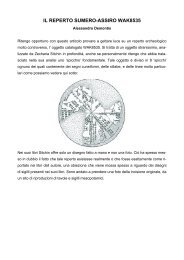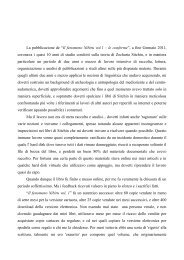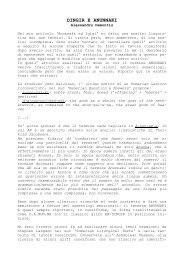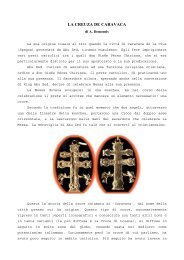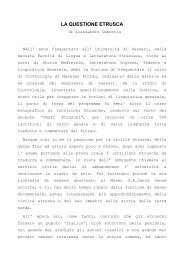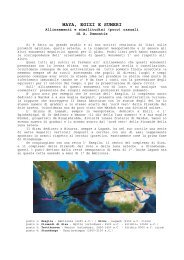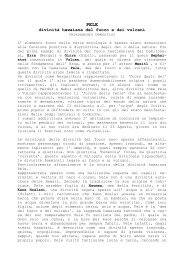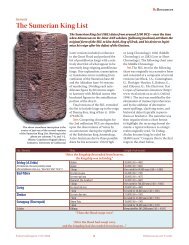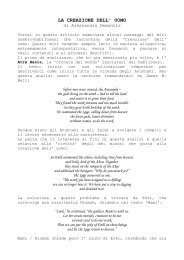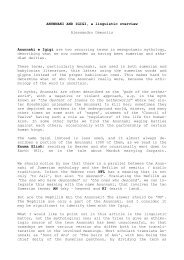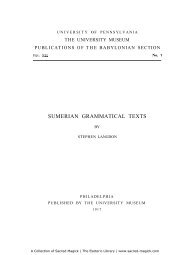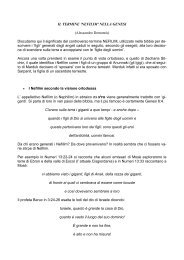LE MOTIVAZIONI DI IAN LAWTON Per comprendere bene il motivo ...
LE MOTIVAZIONI DI IAN LAWTON Per comprendere bene il motivo ...
LE MOTIVAZIONI DI IAN LAWTON Per comprendere bene il motivo ...
You also want an ePaper? Increase the reach of your titles
YUMPU automatically turns print PDFs into web optimized ePapers that Google loves.
His original fam<strong>il</strong>y tree lists three: Marduk, Dumuzi and Nergal;<br />
[…] But worse st<strong>il</strong>l by the time of The Wars of Gods and Men (1985)<br />
he is referring to six sons of Enki, although he proceeds to only list five:<br />
Marduk, Dumuzi, Nergal, Gib<strong>il</strong> (who this time gets a mention) and Ninagal<br />
(a little-known deity). By contrast, when we come to The Lost Realms<br />
(1990) we find him introducing another new son, Ningishzida.<br />
Insomma siccome Sitchin in un libro nomina solo tre figli di Enki, in un altro libro<br />
cinque e in un altro ancora introduce un sesto, secondo Lawton la genealogia di Enki<br />
sarebbe controversa. Vorrei qui far notare che i testi di Sitchin non sono degli elenchi di<br />
genealogie, e si introducono le divinità generalmente quando si parla di loro in riferimento<br />
a qualcosa. Nonostante ciò, Lawton mostra di non aver letto attentamente i libri di Sitchin<br />
per due motivi: Gib<strong>il</strong> viene introdotto sin dal primo libro ‘Il pianeta degli dei’ (1976 –<br />
capitolo 11 – ammutinamento degli anunnaki) quando si afferma che:<br />
As Lord of the Abzu, Ea was assisted by another son, the god GI.BIL<br />
(“he who burns the so<strong>il</strong>”), who was in charge of fire and smelting.<br />
Earth’s Smith, he was usually depicted as a young god<br />
whose shoulders emit red-hot rays or sparks of fire, emerging from the<br />
ground or about to descend into it. The texts state that Gib<strong>il</strong> was steeped<br />
by Ea in “wisdom,” meaning that Ea had taught him mining techniques.<br />
Inoltre è nel libro ‘Guerre atomiche al tempo degli dei’ (1985 – The wars of God and<br />
men) che Ningishzidda viene introdotto (capitolo 9 – Pace sulla terra) identificandolo<br />
subito come figlio di Enki, con tanto di evidenze iconografiche che lo mostrano con i fregi<br />
del serpente proprio come Enki e con l’ Ankh egizio. Successivamente nel libro ‘Gli dei<br />
dalle lacrime d oro’ (1990 – The lost realms), la figura di Ningishzidda viene trattata<br />
estensivamente poiché questo è <strong>il</strong> libro nel quale Sitchin si concentra sul contatto tra<br />
medioriente e mesoamerica analizzando la figura del ‘serpente piumato’ e del ‘drago’<br />
assim<strong>il</strong>ando appunto Ningishzidda a Quetzalcoatl.<br />
Abbiamo già parlato in un altro capitolo della figura di Nergal e poco più sopra della<br />
parentela di Ningishzidda, e segnaliamo che in effetti mentre tutte le prove iconografiche lo<br />
aff<strong>il</strong>iano ad Enki e alcuni testi (pur se frammentari) confermano questa parentela, altri testi<br />
40



